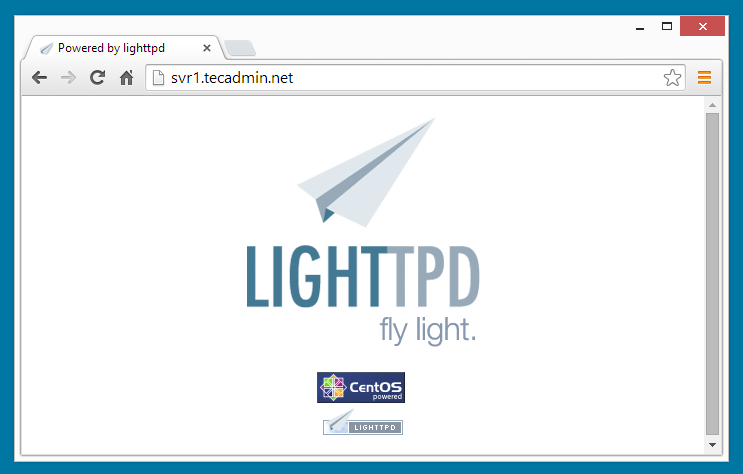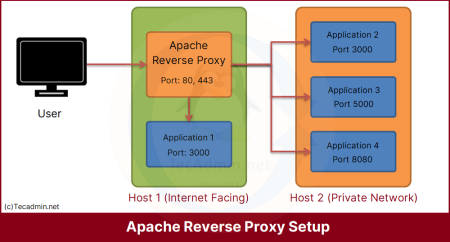Lighttpd is high performance web server created suitable for running on production environment. It is highly optimize, secure and very flexible web server. Lighttpd utilize very low Memory and CPU than other web servers. Its event-driven architecture is optimized for a large number of parallel connections (keep-alive)
Lighttpd powers several popular Web 2.0 sites. It provides high speed io-infrastructure which allows them to scale several times better with the same hardware. This is developed with keeping future web in mind like:
- Faster FastCGI
- COMET meets mod_mailbox
- Async IO
Follow the steps below to install Lighttpd on RHEL based systems.
Step 1: Add EPEL Repository
At the time of writing article EPEL yum repository have the latest package of Lighttpd, First add EPEL yum repository your system.
# rpm -Uvh http://download.fedoraproject.org/pub/epel/6/i386/epel-release-6-8.noarch.rpm
Step 2: Install Lighttpd Server
Install Lighttpd using yum package manager
# yum install lighttpd lighttpd-fastcgi
Loaded plugins: fastestmirror, refresh-packagekit, security Loading mirror speeds from cached hostfile * base: mirror.nbrc.ac.in * epel: mirrors.ispros.com.bd * extras: mirror.nbrc.ac.in * updates: mirror.nhanhoa.com Setting up Install Process Resolving Dependencies --> Running transaction check ---> Package lighttpd.i686 0:1.4.35-1.el6 will be installed ---> Package lighttpd-fastcgi.i686 0:1.4.35-1.el6 will be installed --> Processing Dependency: spawn-fcgi for package: lighttpd-fastcgi-1.4.35-1.el6.i686 --> Running transaction check ---> Package spawn-fcgi.i686 0:1.6.3-1.el6 will be installed --> Finished Dependency Resolution Dependencies Resolved =================================================================================================== Package Arch Version Repository Size =================================================================================================== Installing: lighttpd i686 1.4.35-1.el6 epel 300 k lighttpd-fastcgi i686 1.4.35-1.el6 epel 45 k Installing for dependencies: spawn-fcgi i686 1.6.3-1.el6 epel 16 k Transaction Summary =================================================================================================== Install 3 Package(s) Total download size: 361 k Installed size: 818 k Is this ok [y/N]: y Downloading Packages: (1/3): lighttpd-1.4.35-1.el6.i686.rpm | 300 kB 00:00 (2/3): lighttpd-fastcgi-1.4.35-1.el6.i686.rpm | 45 kB 00:00 (3/3): spawn-fcgi-1.6.3-1.el6.i686.rpm | 16 kB 00:00 --------------------------------------------------------------------------------------------------- Total 206 kB/s | 361 kB 00:01 Running rpm_check_debug Running Transaction Test Transaction Test Succeeded Running Transaction Warning: RPMDB altered outside of yum. ** Found 1 pre-existing rpmdb problem(s), 'yum check' output follows: google-chrome-stable-34.0.1847.116-1.i386 has missing requires of libnss3.so(NSS_3.14.3) Installing : lighttpd-1.4.35-1.el6.i686 1/3 Installing : spawn-fcgi-1.6.3-1.el6.i686 2/3 Installing : lighttpd-fastcgi-1.4.35-1.el6.i686 3/3 Installed: lighttpd.i686 0:1.4.35-1.el6 lighttpd-fastcgi.i686 0:1.4.35-1.el6 Dependency Installed: spawn-fcgi.i686 0:1.6.3-1.el6 Complete!
Step 3: Configure Lighttpd Server
Before starting Lighttpd configuration, make sure you have selinux disabled in your system.
# getenforece
Now edit Lighttpd configuration file /etc/lighttpd/lighttpd.conf and
server.use-ipv6 = "disable" server.max-fds = 2048
server.use-ipv6: Set this value ot ‘diable’ will allow server to listen on IPv6 connections and disabled IPv6 connection.
server.max-fds Lighttpd is single-threaded server, its main resource limit is the number of file descriptors, which is set to 1024 by default (on most systems). To handle high traffic site set this to 2048.
Step 4: Start Lighttpd Server
Finally start Lighttpd service using following command.
# service lighttpd start
To stop or restart server use following command.
# service lighttpd stop # service lighttpd restart
Make Lighttpd to start on server boot
# chkconfig lighttpd on



1 Comment
“server.use-ipv6: Set this value ot ‘diable’ will allow server to listen on IPv6 connections and disabled IPv6 connection.”
should be ” listen on IPv4″ ?